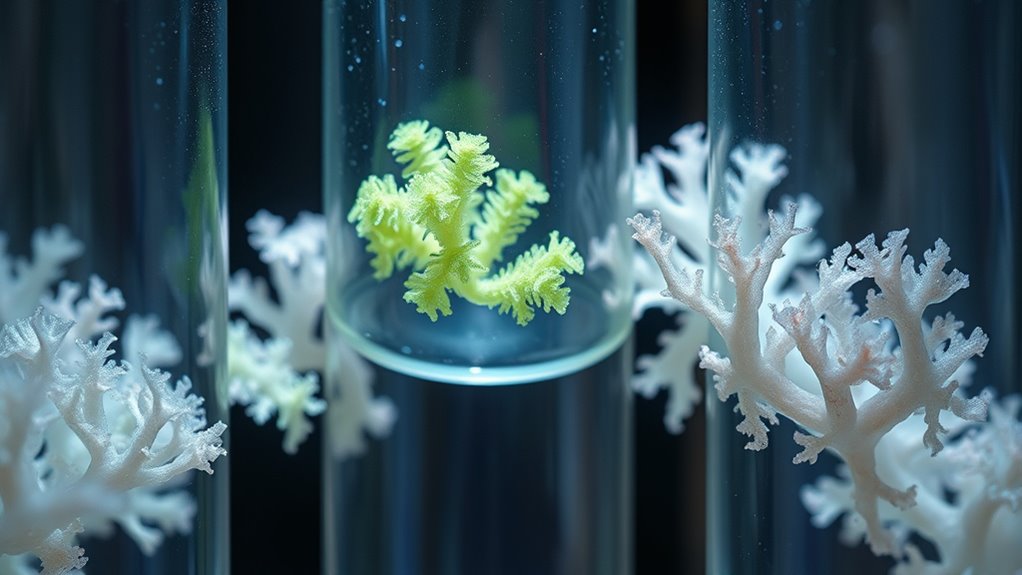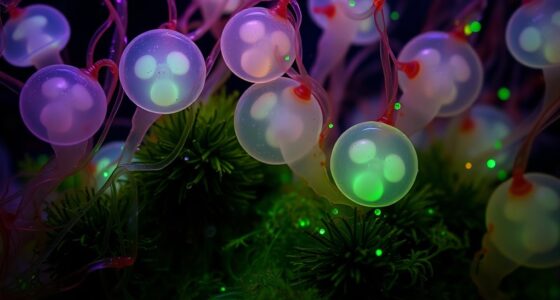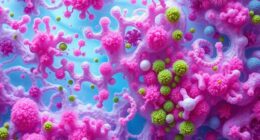Semi-living installations combine biology and art by using tissue culture techniques to create dynamic, organic artworks that grow, change, and decay over time. You can witness living tissues shaped through precise manipulation, influenced by environmental stimuli, and preserved through sterile techniques. These artworks often evoke emotional responses and ethical questions, engaging viewers actively. If you want to explore how science and creativity intertwine to shape the future of biological art, keep exploring further.
Key Takeaways
- Semi-living installations incorporate living tissues grown via tissue culture techniques, blending art and biological processes.
- Artists manipulate and shape cultured tissues using precise biological and environmental controls to create dynamic artworks.
- Ethical considerations include organism dignity, ecological impact, and safety, influencing how semi-living art is developed and displayed.
- Audience engagement is heightened through interactive, responsive installations that evoke emotional connections and provoke reflection on life.
- Future innovations involve gene editing, bioprinting, and bioinformatics, expanding creative possibilities in biological art.
The Evolution of Living Art: A Brief Overview
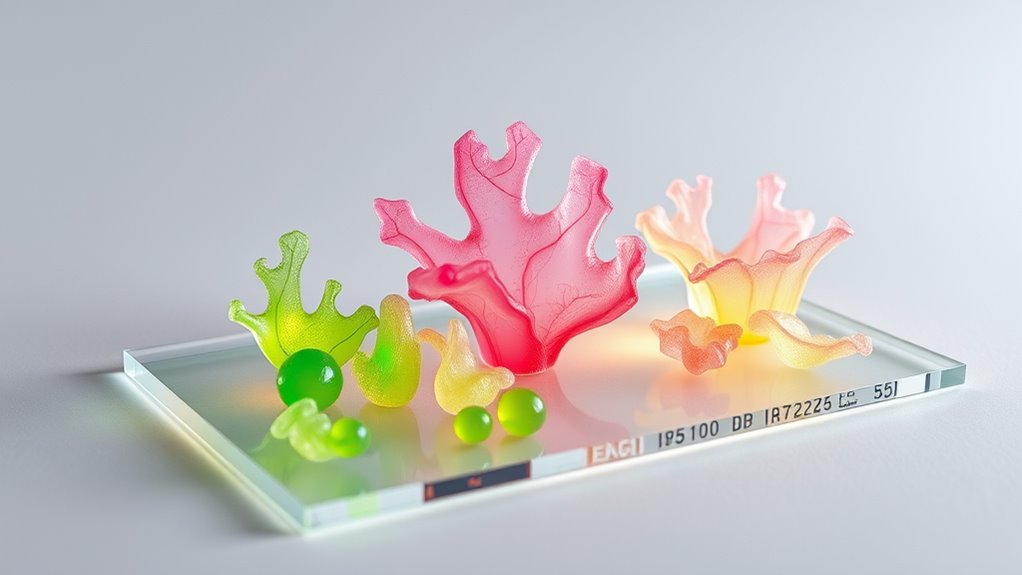
The evolution of living art has transformed how you perceive creativity and nature. It started with artists experimenting with organic materials, blurring the line between art and life. Over time, artists began integrating living organisms into their works, creating dynamic, ever-changing pieces. This shift challenged traditional notions of permanence and craftsmanship. Instead, living art emphasizes growth, decay, and transformation, engaging viewers in new ways. As technology and biological sciences advanced, artists gained tools to manipulate living tissues directly. Today, living art often involves biological processes, fostering a deeper connection between humans and the natural world. This evolution reflects a desire to redefine art’s boundaries, making it more interactive, sustainable, and reflective of life’s inherent vitality. Additionally, the rise of tissue culture techniques has enabled artists to cultivate living materials in controlled environments, expanding the possibilities of what can be considered art.
Techniques Behind Tissue Culture Artworks

To create tissue culture artworks, you’ll need to understand the specific culturing techniques and materials involved. You’ll also explore artistic manipulation methods to shape and display the living elements effectively. Additionally, considering preservation and sustainability guarantees these installations remain vibrant and ethically responsible over time. Proper storage conditions, such as cool dark places, are essential to maintain the vitality of the cultured tissues.
Culturing Techniques and Materials
Creating tissue culture artworks involves precise techniques and carefully selected materials that enable living tissues to grow and transform into artistic forms. You begin by choosing the right biological material, such as plant or animal cells, suited for your project. Sterilization is vital; you must thoroughly clean tools, containers, and growth media to prevent contamination. Next, you prepare the culture medium—rich in nutrients, hormones, and supplements—tailored to support your tissue’s specific needs. You then isolate or excise tissues, placing them in sterile conditions, and carefully position them on or within the medium. Maintaining proper environmental conditions like temperature, humidity, and light ensures healthy growth. These foundational techniques allow your living materials to develop into intricate, living artworks. Proper environmental controls are essential for consistent and successful tissue culture development.
Artistic Manipulation Methods
Once you’ve established a healthy culture, you can begin to shape and modify your living materials to achieve your artistic vision. Start by employing precise cutting and sculpting techniques to carve or mold tissues into desired forms. Use micro-manipulation tools, such as fine tweezers or scalpels, to selectively remove or add cells, creating contrast and texture. Apply controlled stimuli—light, temperature, or chemical cues—to influence growth patterns and coloration. Consider layering tissues or combining different cell types to generate complex, multi-dimensional effects. Regularly monitor and adjust environmental conditions to guide development. Throughout the process, maintain a delicate balance between nurturing growth and enforcing artistic intent, transforming living tissues into dynamic, expressive artworks that evolve over time.
Preservation and Sustainability
Preserving tissue culture artworks requires careful techniques that guarantee their longevity and ecological sustainability. You must maintain sterile environments to prevent contamination and guarantee the health of the living materials. Regular monitoring of temperature, humidity, and nutrient levels helps keep the cultures alive over time. To promote sustainability, you can implement closed-loop systems that recycle water and nutrients, reducing waste. Using eco-friendly growth media and minimizing resource consumption also supports environmental goals. Documentation is essential; recording each step ensures reproducibility and long-term preservation. When artworks reach the end of their lifespan, ethically disposing of biological materials avoids ecological harm. Understanding sustainable practices in tissue culture art helps balance ecological impact with artistic innovation. By balancing technical precision with eco-conscious practices, you guarantee these living artworks endure while respecting ecological integrity.
Notable Artists and Their Semi-Living Creations

Many contemporary artists are pushing the boundaries of art and biology by designing semi-living installations that blur the line between the organic and the artificial. For example, Eduardo Kac’s bio-art pieces integrate living tissues to evoke emotional and philosophical questions. Oron Catts and Ionat Zurr create “semi-living” sculptures using tissue cultures, exploring life’s fragility. Heather Dewey-Harris transforms biological data into visual works that challenge perceptions of life and technology. These artists don’t just display static objects; they craft evolving, living entities that invite interaction and reflection. Their work demonstrates how art can serve as a platform to question what it means to be alive, challenging traditional notions and expanding creative possibilities through biological processes. Additionally, these creations often highlight the health risks and allergies related to tissue culture, encouraging awareness of biological safety considerations.
Ethical Considerations in Growing Art
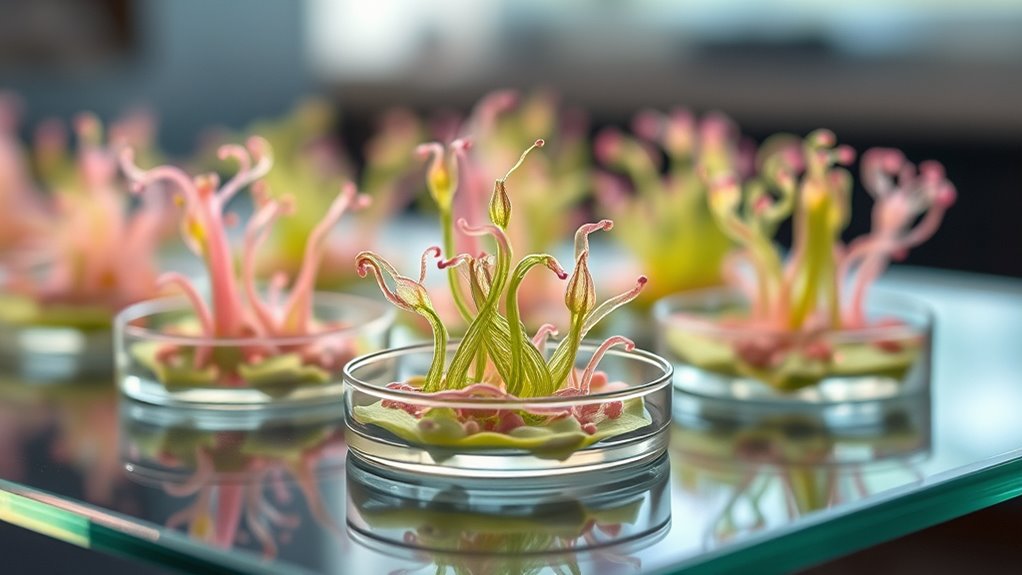
As artists push the boundaries of creating semi-living installations, they encounter complex ethical questions about the implications of cultivating and manipulating living tissues. You must consider questions like whether creating living art respects the dignity of organisms or risks exploitation. Is it ethical to manipulate tissues for aesthetic purposes? You also need to reflect on the potential environmental impacts and the moral responsibilities involved. To deepen understanding, consider this table:
| Ethical Concern | Key Question | Possible Outcome |
|---|---|---|
| Animal welfare | Are living tissues treated humanely? | Ensuring ethical treatment |
| Environmental impact | Does the art harm ecosystems? | Minimizing ecological damage |
| Artistic intent | Is the purpose justified? | Balancing innovation and morality |
Navigating these issues requires careful thought about both artistic expression and ethical boundaries. Additionally, understanding the importance of tissue culture techniques can help artists make more informed decisions about their practices.
The Impact of Semi-Living Installations on Audience Engagement

Semi-living installations create immersive experiences that actively draw you in, making participation feel natural and compelling. As you engage, you may find your emotional responses deepening, forging a stronger connection to the artwork. This dynamic interplay between interaction and emotion transforms how you experience and interpret these installations. Incorporating elements like interactive components inspired by innovative tuning methods can further enhance audience engagement and responsiveness.
Interactive Immersion Effects
Interactive immersion effects in semi-living installations draw viewers into a mesmerizing experience that blurs the line between observer and participant. As you move through the space, your actions influence the living elements, creating a dynamic dialogue. This engagement encourages curiosity and fosters a sense of agency, making you feel connected to the evolving organism. The installation responds to your presence with changes in movement, sound, or visual display, heightening your awareness of the living system’s complexity. You become part of the artwork itself, not just a bystander. This active participation deepens your emotional involvement and invites reflection on the interconnectedness of life and technology. The immersive nature transforms passive viewing into an active, visceral experience, leaving a lasting impression of the living art’s vitality. Detecting and correcting passive voice enhances clarity and strengthens the overall impact of your writing.
Emotional Connection Dynamics
Semi-living installations have a powerful ability to forge emotional bonds with their viewers, transforming passive observation into meaningful engagement. When you encounter these artworks, you don’t just see living tissues; you feel a sense of connection and responsibility. Their fragility and vulnerability evoke empathy, prompting you to reflect on life, mortality, and ethics. The unpredictability of biological processes can also generate curiosity and wonder, deepening your emotional involvement. As you observe the evolution or decay of these structures, you become emotionally invested, often feeling a sense of intimacy or concern. This emotional response bridges the gap between art and audience, fostering a personal experience that lingers beyond the initial encounter. Ultimately, semi-living installations invite you to connect on a visceral level, making the experience unforgettable.
Future Directions and Innovations in Biological Art

How might emerging technologies reshape the future of biological art? You can expect breakthroughs in gene editing, bioprinting, and synthetic biology to push creative boundaries. Artists will gain new tools to manipulate living tissues, creating dynamic, responsive installations that evolve over time. Advancements in bioinformatics will enable precise control over cellular behavior, allowing for more complex and interactive artworks. Wearable bio-sensors and augmented reality could merge biological elements with digital interfaces, enhancing viewer engagement. Additionally, improved materials and cultivation techniques will make semi-living art more accessible and sustainable. Understanding bioinformatics will be crucial for artists to harness these innovations effectively. These innovations will blur lines between science and art, fostering collaborations that challenge traditional notions of creativity. As technology advances, you’ll see biological art become more immersive, personalized, and capable of addressing ecological and social issues.
Bridging Science and Creativity: Challenges and Opportunities

Bridging science and creativity in biological art presents both exciting opportunities and significant challenges. You may find that integrating scientific techniques into artistic practice opens new frontiers for expression, allowing you to explore living materials in novel ways. However, working across these disciplines requires you to navigate complex ethical considerations, safety protocols, and technical limitations. You need to balance scientific rigor with artistic vision, which can be difficult when priorities differ. Funding and institutional support might also pose obstacles, as biological art often blurs traditional boundaries. Despite these hurdles, collaboration between scientists and artists creates innovative opportunities to challenge perceptions and expand cultural conversations around life and technology. Embracing these challenges can lead to groundbreaking works that inspire dialogue and deepen understanding of the living world. Developing cultural intelligence can help navigate the diverse perspectives involved in interdisciplinary projects.
Frequently Asked Questions
How Long Do Semi-Living Installations Typically Last Before Deterioration?
Semi-living installations usually last from a few weeks to several months before deterioration, depending on factors like environmental conditions and maintenance. You’ll want to monitor humidity, temperature, and light levels closely to extend their lifespan. Regular care helps prevent decay and keeps your installation vibrant longer. Keep in mind, some installations are designed for short-term display, so plan your project timeline accordingly to showcase the artwork at its best.
What Maintenance Is Required for Tissue Culture Artworks Over Time?
You need to regularly monitor your tissue culture artworks for contamination, mold, or discoloration. Keep the environment clean and maintain ideal humidity and temperature levels. Refresh nutrients and media as needed to support growth. Handle the pieces gently to prevent damage, and adjust lighting based on the specific species. Consistent care ensures your semi-living installation thrives and remains visually stunning over time.
Are There Legal Restrictions on Creating and Displaying Semi-Living Art?
Yes, there are legal restrictions on creating and displaying semi-living art. You need to adhere to laws related to bioethics, animal and plant rights, and environmental regulations. These laws vary by location, so you should research local, national, and international rules. Obtain necessary permits, ensure proper safety measures, and respect intellectual property rights. Staying informed and consulting legal experts helps you avoid violations and responsibly showcase your semi-living art.
How Do Artists Ensure the Ethical Sourcing of Biological Materials?
You understand that “honesty is the best policy,” so you guarantee ethical sourcing by researching your suppliers and choosing reputable laboratories. You obtain proper permissions, follow legal regulations, and prioritize transparency about your materials. You also respect biodiversity and avoid exploiting vulnerable species. By staying informed and practicing integrity, you create art that respects both scientific standards and ethical boundaries, fostering trust and responsible innovation in your work.
Can Viewers Interact Safely With Semi-Living Art Installations?
Yes, you can interact safely with semi-living art installations if the artists implement proper safety measures. They typically provide clear guidelines, use barrier protections, and guarantee the biological materials are non-toxic and sterile. Follow all instructions carefully, avoid direct contact unless permitted, and wash your hands afterwards. These precautions protect you while allowing you to experience the innovative, living art without risking health or safety.
Conclusion
As you explore the world of semi-living installations, you realize the boundaries between art and biology are blurring in ways never imagined. What will emerge when science’s precision meets creative daring? Will these living artworks challenge ethical norms or redefine artistic expression? The future holds untapped potential—and perhaps unforeseen dilemmas—that could reshape how we perceive life itself. Prepare to question everything as you step into this evolving, mysterious frontier of biological art.
